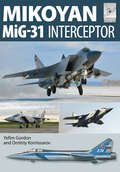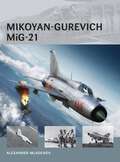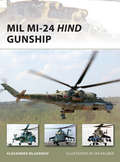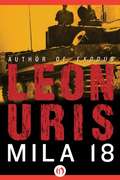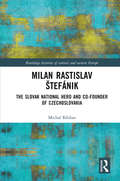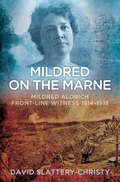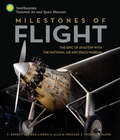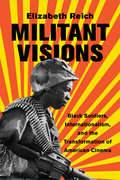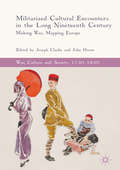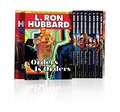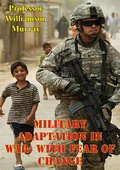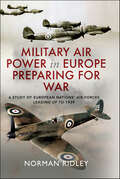- Table View
- List View
Mikoyan MiG-31: Interceptor (FlightCraft)
by Yefim Gordon Dmitriy KomissarovA history of this advanced Russian jet, including useful information for model makers. The MiG-31 started life as an advanced derivative of the famous MiG-25P interceptor, becoming the first Soviet fourth-generation combat aircraft. First flown in 1975, it differed from its progenitor primarily in having a crew of two (pilot and weapons systems operator), a highly capable passive phased-array radar—a world first—and new R-33 long-range missiles as its primary armament. The maximum speed was an impressive Mach 2.82, the cruising speed being Mach 2.35. The type entered service in 1981; more than 500 copies were built between 1981 and 1994. The powerful radar and other avionics allowed the MiG-31 to operate as a &“mini-AWACS&” scanning the airspace and guiding other interceptors to their targets; a flight of three such aircraft in line abreast formation could cover a strip 800 km (500 miles) wide. To this day the MiG-31 remains one of the key air defense assets of the Russian Air Force. This book describes the MiG-31&’s developmental history, including upgrade programs, and features a comprehensive survey of the MiG-31 model-making kits available on the market.
Mikoyan-Gurevich MiG-21
by Alexander Miladenov Adam ToobyThe MiG-21, nicknamed 'Fishbed' by NATO, was the primary Soviet jet fighter from 1972 onward, opposing the F-15 Eagle and F-14 Tomcat worldwide in a variety of conflicts.The MiG-21 firmly holds the title of the world's most widely built and used jet fighter, with over 10,000 units rolling off the lines of three plants in the former Soviet Union. The type was also built under license in India and Czechoslovakia, and without license in China until the late 2000s. Designed as a Mach-2 light tactical fighter, its original prototype, the Ye-6/1, was first flown in 1958. The first production variant of the type, designated the MiG-21F, appeared in 1960 and its improved sub-variant, the MiG-21F-13 (Type 74, NATO reporting name Fishbed-C), was made available for export by 1961. It was a simplified daytime short-range, clear-weather interceptor and tactical fighter. The MiG-21F-13 featured a relatively weak armament of just two R-3S air-to-air missiles (AA-2 Atoll, a slightly improved reverse-engineered copy of the AIM-9B Sidewinder heat-seeking AAM) with an effective range at low altitude of between 0.27nm/0.5km and 1.1nm/2km. According to its pilots, the MiG-21F-13 was an excellent clear-day interceptor though it had limited combat radius and poor night capability. The light and agile aircraft was designed from the outset to intercept transonic/supersonic bombers and tactical fighters at all altitudes, up to 66,000ft. The MiG-21bis was the last version of the type that took the air for the first time in 1969, with the first production examples rolling off the line in 1972. The MiG-21bis featured a strengthened fuselage, optimised for low-level air combat and ground attack. It was powered by the upgraded R-25-300 turbojet, rated at 40.2kN (9,038lb) dry and 69.65kN (15,653lb) with reheat, featuring a three-minute emergency reheat rating of 97 kN (21,790 lb) at low level. Pilots noted, however, that the heavier 'bis' was much less agile than the MiG-21PF/PFM, and that it behaved like a "bull" in the air while flying the MiG-21PFM was like "riding a stallion." The MiG-21bis was a successful combination of a 1960s airframe and powerplant fitted with a 1970s-vintage analog avionics suite and modern dogfight missiles. By the mid-1980s, although it retained the principal shortcomings of its predecessors - limited operational radius and radar range, lack of beyond-visual-range missiles, poor pilot visibility, mediocre slow speed handling characteristics and high pilot workload, requiring hard training and concentration during the entire sortie - it proved to be an inexpensive and widely popular combat aircraft.
Mil Mi-24 Hind Gunship
by Ian Palmer Alexander MiladenovWith its distinctive double-cockpit design, the Mi-24 'Hind' is arguably the most recognizable war machine of the Cold War, and has achieved near-legendary status in the annals of military history. The first Soviet helicopter to function as both a gunship and an assault transport, it served extensively in Afghanistan, and is now employed by militaries across the world. Written by an expert on the 'Hind', and drawing on manufacturing and military sources, this book presents the Mi-24 in all of its brutal glory, from design and development to deployment and combat. Also included are a number of color plates showing the distinct paint schemes employed by various nations in a range of theaters and for different armies.
Mila 18
by Leon UrisIn a bunker underneath 18 Mila Street, a determined band of Warsaw Jews resist Nazi occupiers Italian-American journalist Christopher de Monti finds himself in Nazi-controlled Warsaw before the outbreak of World War II. Though wined and dined by German officers eager for sympathetic coverage, de Monti's nose for the real story soon leads him to discover the terrifying conditions of the Warsaw ghettos and the Nazis' chilling plans for the ghettos' inhabitants. He soon comes to know the Jewish resistance movement and joins their courageous--if doomed--last stand. Mila 18 is one of Uris's most powerful and heartfelt novels and is the product of meticulous research of pre-WWII Warsaw. This ebook features an illustrated biography of Leon Uris including rare photos from the author's estate.
Milan Rastislav Štefánik: The Slovak National Hero and Co-Founder of Czechoslovakia (Routledge Histories of Central and Eastern Europe)
by Michal KšiňanThis is the first scientific biography of Milan Rastislav Štefánik (1880–1919) that is focused on analysing the process of how he became the Slovak national hero. Although he is relatively unknown internationally, his contemporaries compared him “to Choderlos de Laclos for the use of military tactics in love affairs, to Lawrence of Arabia for vision, to Bonaparte for ambition … and to one of apostles for his conviction”. He played the key role in founding an independent Czechoslovakia in 1918 through his relentless worldwide travels during the First World War in order to create the Czechoslovak army: he visited Serbia and Romania on the eve of invasion by the Central Powers, Russia before the February revolution, the United States after it declared the war to Germany, Italy dealing with the consequences of the defeat in Caporetto battle, and again Russia plunged into the Civil War. Several historical methods are used to answer this question such as social capital to explain his raise in French society, the charismatic leader to understand how he convinced and won over a relatively large number of people; more traditional political, military and diplomatic history to show his contribution to the founding of Czechoslovakia, and memory studies to analyse his extraordinary popularity in Slovakia. By mapping his intriguing life, the book will be of interest to scholars in a broad range of areas including history of Central Europe, especially Czechoslovakia, international relations, social history, French society at the beginning of the 20th century and biographical research.
Mildred on the Marne: Mildred Aldrich, Front-line Witness 1914-1918
by David Slattery-ChristyThis is the story of 61-year-old Mildred Aldrich and her experiences of the Great War. She retired to a small hill-top house called La Creste in February 1914, with views across the Marne river and valley, little realising she would become embroiled in the first major battle of the war. In spite of the danger she decided to stay and help the British soldiers. Her home was for a few days behind German lines but the British pushed the Germans into retreat and La Creste remained in British territory for the duration. They entrenched in the Marne Valley and Mildred's 'beloved panorama' as she described the view, turned into the valley of horror and death. Informed by journalist Mildred's unpublished journals and voices of those serving in the BEF, along with historical military background, this book examines events from the unique perspective of a remarkable woman who lived through them.
Milestones of Flight: The Epic of Aviation with the National Air and Space Museum
by F. Robert van der Linden Alex M. Spencer Thomas J. PaoneExperience the history of flight with the world-class aviation collection at the Smithsonian's National Air and Space Museum, which attracts millions and millions of visitors each year in Washington, D.C.From the moment the Wright Brothers first took flight in 1903 to the modern-day reliance on stealth aircraft and drones, there have been significant advances made in aviation. Milestones of Flight celebrates each era of advancements by showcasing the Smithsonian National Air and Space Museum's world-class aircraft collection. Authored by Dr. Robert van der Linden, a leading expert on aviation and Chairman of the Aeronautics Department at the NASM, this book is a stunning profile of the advancements in flight from decade to decade, illustrated with beautiful, large-scale photography and enhanced with little-known facts, anecdotes, and insights from major players in the aviation industry.Climb inside the cockpit of the Spirit of St. Louis that Charles Lindbergh piloted solo across the Atlantic Ocean, making history. Contrast that with a Boeing B-29 Superfortress, the first aircraft to drop an atomic bomb. The full-page photos of each milestone-making aircraft are accompanied by timelines to showcase related aircraft as well as sidebars with interesting and little-known facts, stories, and related research.Milestone categories include:- Era of Early Flight- World War I First Fighters- Long-Range Record-Setting Flight- Popular Flight- First Commercial Airliners- World War II Aircraft- Experimental Flight- Cold War Military/Korean Conflict Aircraft- Commercial Jets- Modern Military AircraftWhat will the next milestone be?
Militant Visions: Black Soldiers, Internationalism, and the Transformation of American Cinema
by Elizabeth ReichMilitant Visions examines how, from the 1940s to the 1970s, the cinematic figure of the black soldier helped change the ways American moviegoers saw black men, for the first time presenting African Americans as vital and integrated members of the nation. In the process, Elizabeth Reich reveals how the image of the proud and powerful African American serviceman was crafted by an unexpected alliance of government propagandists, civil rights activists, and black filmmakers. Contextualizing the figure in a genealogy of black radicalism and internationalism, Reich shows the evolving images of black soldiers to be inherently transnational ones, shaped by the displacements of diaspora, Third World revolutionary philosophy, and a legacy of black artistry and performance. Offering a nuanced reading of a figure that was simultaneously conservative and radical, Reich considers how the cinematic black soldier lent a human face to ongoing debates about racial integration, black internationalism, and American militarism. Militant Visions thus not only presents a new history of how American cinema represented race, but also demonstrates how film images helped to make history, shaping the progress of the civil rights movement itself.
Militarism and the British Left, 1902–1914: 1902-1914
by Matthew JohnsonMilitarism has traditionally been regarded as a phenomenon of the political right. As this book demonstrates, however, various groups on the political left in Britain during the years before the Great War were able to accommodate, and even assimilate, militaristic ideas, sentiments, and policies to a remarkable degree.
Militarization and Arms Production (Routledge Library Editions: International Security Studies #12)
by Helena Tuomi, Raimo vÄyrynenThis book, first published in 1983, contains articles written as a result of the UN 1978-81 study on the relationship between disarmament and development. They analyse the disruptive, retarding and weakening effects of large-scale military preparations on the economic and social fabric of societies around the world. They discuss the benefits of disarmament, and how resources could be converted into constructive civilian uses and national development, particularly in developing countries.
Militarization, Internal Repression and Social Welfare in the Third World (Routledge Revivals)
by Miles D WolpinFirst published in 1986, Militarization, Internal Repression and Social Welfare in the Third World argues that there is a relationship between the level of a regime’s military spending and the degree of internal repression it inflicts. This book presents a detailed empirical analysis of this situation and presents the results of more than three dozen researchers who have published comparative or case studies of the substitution effects of military expenditures in socio-economic areas. While the primary concern is with the Third World, the book also analyses the costs to advanced capitalist and to state socialist systems and discusses their role in further militarization. This book will be of interest to students of political science, international relations, colonialism and area studies.
Militarized Cultural Encounters in the Long Nineteenth Century: Making War, Mapping Europe (War, Culture and Society, 1750-1850)
by John Horne Joseph ClarkeThis book explores European soldiers’ encounters with their continent’s exotic frontiers from the French Revolution to the First World War. In numerous military expeditions to Italy, Spain, Russia, Greece and the ‘Levant’ they found wild landscapes and strange societies inhabited by peoples who needed to be ‘civilized.’ Yet often they also discovered founding sites of Europe’s own ‘civilization’ (Rome, Jerusalem) or decaying reminders of ancient grandeur. The resulting encounters proved seminal in forging a military version of the ‘civilizing mission’ that shaped Europe’s image of itself as well as its relations with its own periphery during the long nineteenth century.
Militarized Maternity: Experiencing Pregnancy in the U.S. Armed Forces
by Megan D. McFarlaneThe rights of pregnant workers as well as (the lack of) paid maternity leave have increasingly become topics of a major policy debate in the United States. Yet, few discussions have focused on the U.S. military, where many of the latest policy changes focus on these very issues. Despite the armed forces' increases to maternity-related benefits, servicewomen continue to be stigmatized for being pregnant and taking advantage of maternity policies. In an effort to understand this disconnect, Megan McFarlane analyzes military documents and conducts interviews with enlisted servicewomen and female officers. She finds a policy/culture disparity within the military that pregnant servicewomen themselves often co-construct, making the policy changes significantly less effective. McFarlane ends by offering suggestions for how these policy changes can have more impact and how they could potentially serve as an example for the broader societal debate.
Militarized Modernity and Gendered Citizenship in South Korea
by Seungsook MoonThis pathbreaking study presents a feminist analysis of the politics of membership in the South Korean nation over the past four decades. Seungsook Moon examines the ambitious effort by which South Korea transformed itself into a modern industrial and militarized nation. She demonstrates that the pursuit of modernity in South Korea involved the construction of the anticommunist national identity and a massive effort to mold the populace into useful, docile members of the state. This process, which she terms "militarized modernity," treated men and women differently. Men were mobilized for mandatory military service and then, as conscripts, utilized as workers and researchers in the industrializing economy. Women were consigned to lesser factory jobs, and their roles as members of the modern nation were defined largely in terms of biological reproduction and household management. Moon situates militarized modernity in the historical context of colonialism and nationalism in the twentieth century. She follows the course of militarized modernity in South Korea from its development in the early 1960s through its peak in the 1970s and its decline after rule by military dictatorship ceased in 1987. She highlights the crucial role of the Cold War in South Korea's militarization and the continuities in the disciplinary tactics used by the Japanese colonial rulers and the postcolonial military regimes. Moon reveals how, in the years since 1987, various social movements--particularly the women's and labor movements--began the still-ongoing process of revitalizing South Korean civil society and forging citizenship as a new form of membership in the democratizing nation.
Militarizing Artificial Intelligence: Theory, Technology, and Regulation (Routledge Studies in Conflict, Security and Technology)
by Nik Hynek Anzhelika SolovyevaThis book examines the military characteristics and potential of Artificial Intelligence (AI) in the new global revolution in military affairs. Offering an original perspective on the utilization, imagination, and politics of AI in the context of military development and weapons regulation, the work provides a comprehensive response to the question of how we might reflect on the AI revolution in warfare and what can be said about the ways in which this has been handled. In the first part of the book, AI is accommodated, both theoretically and empirically, in the strategic context of the 'Revolution in Military Affairs' (RMA). The book offers a novel understanding of autonomous weapons as multi-layered composite systems, pointing to a complex, non-linear interplay between evolutionary and revolutionary dynamics. In the second section, the book provides an impartial analysis of the related politics and operations of power, whereby increases in military budgets and R&D of the great powers are met and countered by advocacy networks and scientists campaigning for a ban on lethal autonomous weapons. As such, it moves beyond popular caricatures of ‘killer robots’ and points out some of the problems which result from over-reliance on such imagery. This book will be of much interest to students of strategic studies, critical security studies, arms control and disarmament, science and technology studies and general International Relations.
Militarizing Men: Gender, Conscription, and War in Post-Soviet Russia
by Maya EichlerA state's ability to maintain mandatory conscription and wage war rests on the idea that a "real man" is one who has served in the military. Yet masculinity has no inherent ties to militarism. The link between men and the military, argues Maya Eichler, must be produced and reproduced in order to fill the ranks, engage in combat, and mobilize the population behind war. In the context of Russia's post-communist transition and the Chechen wars, men's militarization has been challenged and reinforced. Eichler uncovers the challenges by exploring widespread draft evasion and desertion, anti-draft and anti-war activism led by soldiers' mothers, and the general lack of popular support for the Chechen wars. However, the book also identifies channels through which militarized gender identities have been reproduced. Eichler's empirical and theoretical study of masculinities in international relations applies for the first time the concept of "militarized masculinity," developed by feminist IR scholars, to the case of Russia.
Militarizing Outer Space: Astroculture, Dystopia and the Cold War (Palgrave Studies in the History of Science and Technology)
by Alexander C. T. Geppert Daniel Brandau Tilmann SiebeneichnerMilitarizing Outer Space explores the dystopian and destructive dimensions of the Space Age and challenges conventional narratives of a bipolar Cold War rivalry. Concentrating on weapons, warfare and violence, this provocative volume examines real and imagined endeavors of arming the skies and conquering the heavens. The third and final volume in the groundbreaking European Astroculture trilogy, Militarizing Outer Space zooms in on the interplay between security, technopolitics and knowledge from the 1920s through the 1980s. Often hailed as the site of heavenly utopias and otherworldly salvation, outer space transformed from a promised sanctuary to a present threat, where the battles of the future were to be waged. Astroculture proved instrumental in fathoming forms and functions of warfare’s futures past, both on earth and in space. The allure of dominating outer space, the book shows, was neither limited to the early twenty-first century nor to current American space force rhetorics.
Militarizing the Nation: The Army, Business, and Revolution in Egypt
by Zeinab Abul-MagdEgypt's army portrays itself as a faithful guardian "saving the nation." Yet saving the nation has meant militarizing it. Zeinab Abul-Magd examines both the visible and often invisible efforts by Egypt's semi-autonomous military to hegemonize the country's politics, economy, and society over the past six decades. The Egyptian army has adapted to and benefited from crucial moments of change. It weathered the transition to socialism in the 1960s, market consumerism in the 1980s, and neoliberalism from the 1990s onward, all while enhancing its political supremacy and expanding a mammoth business empire. Most recently, the military has fought back two popular uprisings, retained full power in the wake of the Arab Spring, and increased its wealth.While adjusting to these shifts, military officers have successfully transformed urban milieus into ever-expanding military camps. These spaces now host a permanent armed presence that exercises continuous surveillance over everyday life. Egypt's military business enterprises have tapped into the consumer habits of the rich and poor alike, reaping unaccountable profits and optimizing social command. Using both a political economy approach and a Foucauldian perspective, Militarizing the Nation traces the genealogy of the Egyptian military for those eager to know how such a controversial power gains and maintains control.
Military & War Collection, The
by L. Ron HubbardTriumphant tales of heroes, honor and impossible odds. Launch into the action with these gripping and gritty tales that appeared in the pages of the most popular pulp fiction magazines of the 1930's and 1940's. "It's certainly loads of fun." --Ellery QueenThis Collection includes: International Book Awards Winner: On Blazing Wings, International Book Awards Finalists: The Phantom Patrol & Hostage to Death as well as Orders is Orders, While Bugles Blow!, Sabotage in the Sky, Wind-Gone-Mad, The Falcon Killer, Hell's Legionnaire and Red Death Over China.
Military Adaptation In War: With Fear Of Change
by Professor Williamson MurrayMilitary Adaptation in War addresses one of the most persistent problems that military organizations confront: namely, the problem of how to adapt under the trying, terrifying conditions of war. This work builds on the volume that Professor Williamson Murray edited with Allan Millett on military innovation (a quite different issue, though similar in some respects). In Clausewitzian terms, war is a contest, an interactive duel, which is of indeterminate length and presents a series of intractable problems at every level, from policy and strategy down to the tactical. Moreover, the fact that the enemy is adapting at the same time presents military organizations with an ever-changing set of conundrums that offer up no easy solutions. As the British general, James Wolfe, suggested before Quebec: 'War is an option of difficulties'. Dr Murray provides an in-depth analysis of the problems that military forces confront in adapting to these difficulties.
Military Adaptation in War
by Williamson MurrayMilitary Adaptation in War addresses one of the most persistent, yet rarely examined, problems that military organizations confront: namely, the problem of how to adapt under the trying, terrifying conditions of war. This work builds on the volume that Professor Williamson Murray edited with Allan Millett on military innovation (a quite different problem, though similar in some respects). In Clausewitzian terms, war is a contest, an interactive duel, which is of indeterminate length and presents a series of intractable problems at every level, from policy and strategy down to the tactical. Moreover, the fact that the enemy is adapting at the same time presents military organizations with an ever-changing set of conundrums that offer up no easy solutions. As the British general, James Wolfe, suggested before Quebec: "War is an option of difficulties. " Dr. Murray provides an in-depth analysis of the problems that military forces confront in adapting to these difficulties.
Military Advising and Assistance: From Mercenaries to Privatization, 1815–2007 (Cass Military Studies)
by Donald StokerThis volume presents a number of case studies of military advisors and missions in order to provide clear historical examples of the evolution, functioning and motives of foreign military advising in the modern era. Containing essays by US contributors covering a wide range of countries and spanning nearly 200 years of history, the case studies show the evolution of foreign military advising from ill-organized mercenary units, to professional, government-sponsored teams driven by a desire to cultivate political and economic influence, to Cold War tools for pursuing ideological aims, nation building, and modernization, to post-Cold War elements of alliance integration. Finally, the book highlights the increasing present-day role of private corporations, some of which provide complete military forces, thereby bringing the evolution of foreign military advising full circle. This book will be of interest to students of military history, civil-military relations, peacekeeping, security studies and political science in general.
Military Air Power in Europe Preparing for War: A Study of European Nations' Air Forces Leading up to 1939
by Norman RidleyThe First World War had seen the mechanization of warfare. Battle fronts had become immobilized in the grip of machine-guns and heavy artillery, leading to slaughter on an unprecedented scale. The end of the war saw exhausted governments extricating themselves from the carnage, but some leaders were concerned that, sooner or later, another major war would follow. As France’s Marshal Foch put it, the Treaty of Versailles was only a ‘twenty-year truce’. The overriding concern was to find ways in future of avoiding the kind of static battle fronts that had consumed so many in such futile efforts. Military aviation was seen as the one great innovation that had the potential to do this by revolutionizing warfare. It would not only augment the effectiveness of ground forces in a tactical role, but it also had the means of reaching out strategically beyond the battlefronts to strike at the enemy’s trade, supplies, communications and industrial production. All through the war, military aviation had been firmly under the control of army commanders but there was soon a fierce debate over the way it should develop. The development of an ‘air doctrine’ within each of the major European powers was fraught with difficulty as the nascent air arms struggled, with varying degrees of success, to free themselves from army control to find a new, independent identity. This book examines the way in which these air arms competed for prominence within the military structures of six major European nations – Germany, Britain, France, Soviet Union, Poland and Italy – with different resources, ambitions and philosophies, in the years from the beginning of aviation right up to the start of the Second World War.
Military And Mindful: Eight Essential Elements to Manage Your Military Career and Motherhood
by Benefsheh VerellIn Military and Mindful, Benefsheh Verell combines her knowledge of mindfulness practices with over twenty years in the Army as a Military Police and Information Operations officer to educate service members and their families about the mental, emotional, and physical benefits of yoga and meditation.Being a mom in the military is very difficult because there is always the underlying uncertainty of what the military will bring next. A mom in the military worries about deploying and how her kids will manage once she does. The feeling of guilt emerges for making career choices that take a mother away from her family. In Military and Mindful, mothers in the military learn how to balance their military career and motherhood without the feelings of guilt or stress. Unlike any other resource currently available for active-duty moms, Military and Mindful offers a template to unleashing one&’s internal power. In addition to promoting a focused and positive mindset, Benefsheh Verell reveals how harnessing one&’s internal power is essential to living a First-Class life.
Military Applications of Modeling: Selected Case Studies (Routledge Library Editions: International Security Studies #13)
by Francis P. HoeberThis book, first published in 1981, offers a critical review of the techniques of mathematical modelling and their appropriate application to military operations research – the analysis of data (historical data, exercise and test results, and intelligence) in preparation for war. The virtues of sophistication via simplicity, and the beauty of the artful finesse, emerge as the signature of successful modelling.
